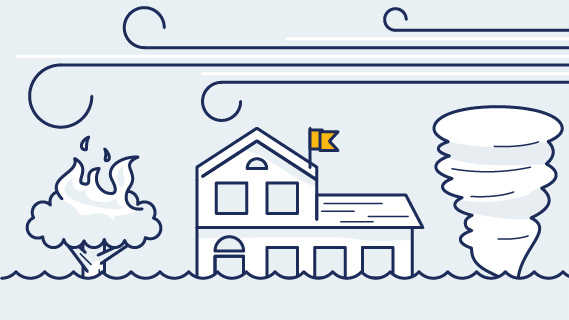As you’re skimming – I mean, reading – your homeowners or renters insurance policy, you’ll come across the word “peril” quite frequently. But what exactly does peril mean in the insurance world?
Well, we’re so glad you asked because it’s something we just cannot stop talking about. The folks over at the International Risk Management Institute define peril as a cause of loss (think windstorm or collision). The list of mishap events or perils your property will be protected against can be found outlined in your insurance policy; however, this doesn’t mean all the known, costly perils that could happen will be included in your plan.
Okay, but what’s multiple-peril insurance?
Let’s start by breaking down the two main types of multiple-peril policies: named peril and open peril. Named-peril plans are very strict and only cover what explicitly listed in your policy, while open-peril policies cover all losses except those listed in the all-encompassing exclusions or other restrictions sections in your plan. These plans make it so you don’t have to purchase separate plans for windstorms, vandalism, fire, what have you.
With both those multiple-peril policies, the key is understanding what exclusions exist in your homeowners or renters policy. After reviewing your policy in-depth, you may realize you need to explore supplemental insurance to cover those concerns – which is often the case when it comes to natural disasters like floods, hurricanes, wildfires, and the damage caused by those events.
Say hello to multi-peril insurance
Yes, while it has fewer letters than multiple-peril policies, it makes a huge difference when it comes to disaster preparedness. Multi-peril insurance offers comprehensive protection from any of the covered severe events and the damage caused by them.
Multi-peril insurance in action
Let’s say a tornado rolls through your town. A single-peril fire plan wouldn’t provide any real benefit if the tornado causes damage to your property. Conversely, a multi-peril policy that includes protection in the event of a fire or tornado would allow benefits for both events.
That’s why we’re here. As the first multi-peril disaster insurance policy, we’re designed to pick up where traditional coverage falls short. Many natural disaster perils are excluded for your typical plan, despite the fact that most people are at risk of facing severe weather events. FEMA even estimates that counties making up 97% of the U.S. populated have been affected by a federally declared disaster since 2010.
Homeowners now face more concerns from natural disasters than ever before, and they need fast and flexible cash to cover unexpected costs (take that costly insurance deductible!). Start by learning what perils are included and excluded from your current policy. Look out for terms like “limits of coverage”, “eligibility”, and “exclusions” as you review your plan. From there, you can identify and fill any gaps against pricey perils in your coverage, not to mention breathe a little easier.

